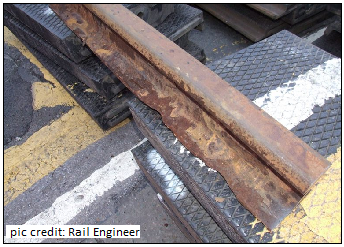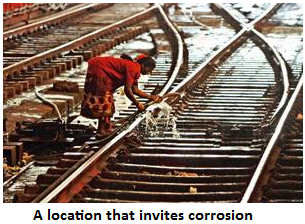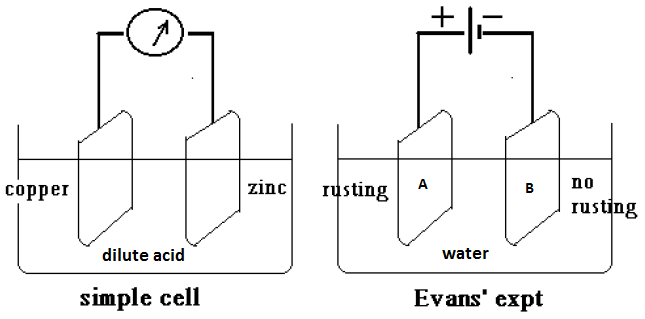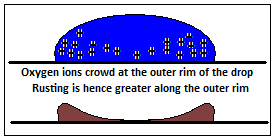Drawing rusting action away from its target could save railway track from pitting and fracture, says S.Ananthanarayanan.
Rusting of iron and steel is not only a multibillion dollar cost that all of us have to bear - damage to steel structures, through rust, leads to disastrous loss of life and vital infrastructure. The loss can be particularly serious when the structure that fails is high speed railway track.
British Steel, a company that came into existence when India’s Tata group sold its interests in the UK steel industry, has announced an innovation that bagged the award for the ‘most interesting new product of the year’, at an event of the national rail industry in Dec 2016. The product is called ZinocoR and consists of a coating that protects rails from corrosion in the harshest conditions.
“Corrosive environments can reduce rail life vastly, with unprotected rail lifetimes below six months being reported in some instances,” says a page in the British Steel website. “Whilst loss of rail section due to corrosion can occur generally or in more localised areas (e.g. around rail fastenings) it is also important to note that foot fatigue failures often occur as a result of foot corrosion. Corrosion pits (often unseen) on the bottom of the rail can initiate fatigue cracks which can then grow undetected, resulting in rail failure,” the website says.

Rusting is not the principal danger that rails face in the normal course, where the punishment from the loads they carry is much more severe. But in specific areas, as in coastal or low lying areas, level crossings or with special fittings, rusting can become a significant threat.

Rusting of iron takes place in the presence of water and oxygen. Water, or H2O, consists of a pair of positively charged hydrogen atoms and a negatively charged oxygen atom, held together by electrical attraction. The components also partially separate and float about as charged particles. When there is also dissolved oxygen in the water, there are more oxygen atoms, which are not balanced by oppositely charged hydrogen atoms, and oxygen combines with iron to form the oxide, which we call rust. Rusting causes wasting away of the pure metal and the oxide with which it is replaced has none of the strength of the original.
As rusting involves the movement of charged particles in water, the presence of salts that increase the electrical conductivity of water leads to faster rusting. This is the reason that salt sea water, even the salty spray in coastal areas, leads to rapid corrosion. In a celebrated experiment, the scientist, Ulick Richardson Evans showed that running a current through a salt solution and a pair of iron plates led to as much rusting of one of the plates as there was electric current.


Even without an external current, within a drop of water, there is a distribution of the charged atoms which acts like an electric cell and drives a current. Within a small drop of water, placed on a piece of iron, negatively charged oxygen atoms repel each other and collect at the outer rim of the drop. This sets up a current from the centre of the drop to the rim, with heavy formation of rust in the iron at the rim of the drop. A simple trial of placing a drop of water on an iron sheet would show that the rust forms as a crater, higher on the outside, with a pit in the centre. Conversely, water that has been boiled to drive out the oxygen is not corrosive, as there is no free oxygen to combine with iron.

Paints and varnish form a coat that physically separates iron and steel from water or moisture. If there is a scratch in the paint cover, rust forms within the scratch and takes the place of the paint lost, and protects the metal underneath. Stainless steel is an alloy of iron, chromium, manganese, silicon and some other metals. These elements react with oxygen contained in water and air to form a very thin, stable film of corrosion products. The film acts like a coat of paint, just a few atoms thick, and it forms very fast, with very little ‘corrosive’ loss of body.
Painting is no use, of course, in the case of railway tracks, as the paint would degrade very fast under the impact of wheels and the rigours of track maintenance. Different specialised coatings also fail under heavy corrosion or mechanical loading. This is the context of the British Steel development, of a covering that diverts any rusting to itself, rather than the steel rails, when there is a breach in the covering.
Sacrificial protection
In the case of the simple cell, shown in the picture, electrons flow from the zinc plate (which is called the anode) to the copper plate (called the cathode), because zinc (being a less ‘noble’ metal) is electrically more active than copper. And as current flows, zinc reacts and passes into solution while hydrogen ions or metal from dissolved copper salts collects at the copper plate. In the case of the iron plates in Evans’ experiment, shown in the picture, electrons flow from the plate, ‘B’ to the plate, ‘A’, and it is the plate, ‘B’ that loses metal to rusting
In the same way, in the case of iron and steel in contact with water, there is a simple cell in action. The iron now plays the part of the anode and loses metal by combining with oxygen to form rust. And the method to protect iron has been, traditionally, to keep the surface clean and dry or covered with a passive layer of grease or paint. The difference in the method developed by the British Steel researchers is to get the covering to play an active role by participating in the electrochemical rusting process.
The ZinocoR cover has a metallic component that is more electrically active than iron (in the same sense that zinc is more active than copper, in the simple cell). In case of a rupture in the ZinocoR cover, the material in the cover takes the role of the anode while the iron that is exposed becomes the cathode. The iron thus collects the positive, hydrogen part of the dissociation of water, in place of oxygen, and is saved from oxidation, or rusting. The loss of metal is of the ZinocoR cover, which becomes the sacrificial anode.
That the new material protects railway track from corrosion has been demonstrated in trials by the track division of British railways, the French national railways and also the tracks in the Paris Metro system, the British Steel website says.
------------------------------------------------------------------------------------------